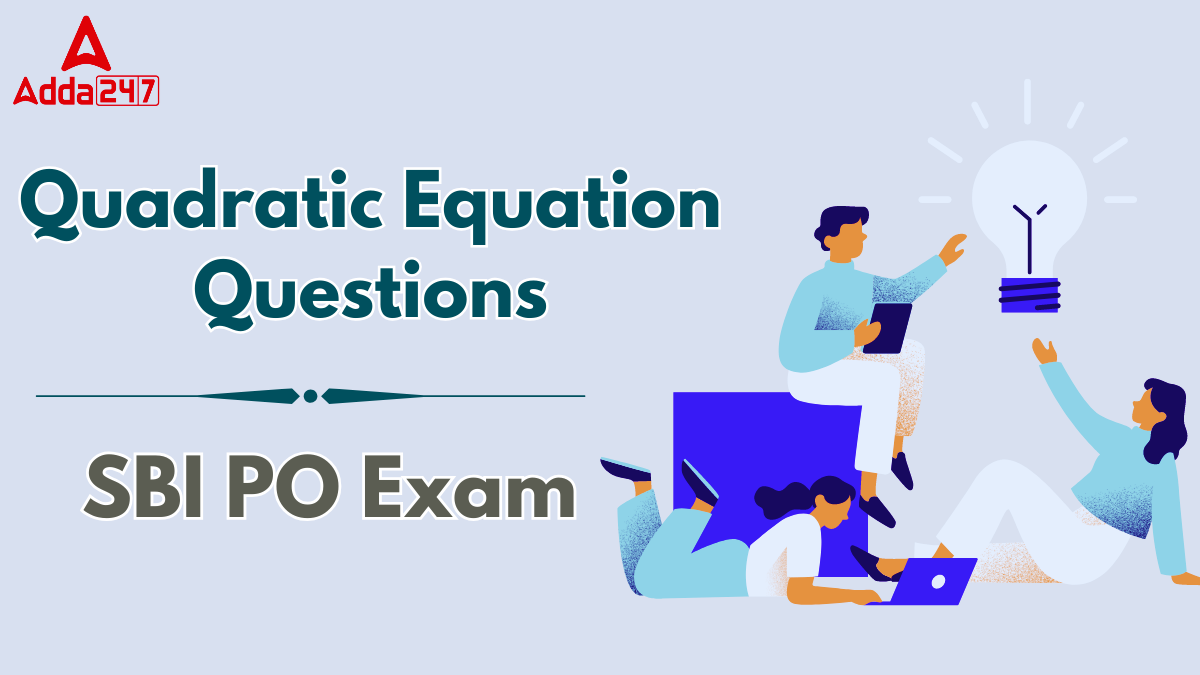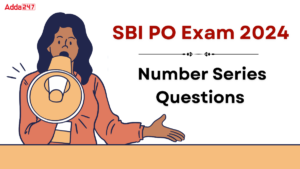Table of Contents
The official SBI PO Notification 2024 is expected to be released soon, and for those preparing for the exam, it is essential to focus on the key areas. One such important topic is Quadratic Equations, which appears in the exam every year. It is a scoring topic and you can solve all the questions with little effort. To make your preparation stronger, we have prepared a series of Quadratic Equations questions for SBI PO exam. The solutions to these questions are given in detail, so that you can improve your understanding and prepare confidently for the exam.
SBI PO: Quadratic Equation Questions Asked in Last 3 Years
Quadratic equation questions in the SBI PO exam are usually based on factorization, the quadratic formula, and comparing roots. Over the last three years, questions have included solving for unknowns, determining relationships between variables and finding maximum or minimum values. Regular practice helps improve speed and accuracy.
Direction (1–5): In each of the following questions two equations are given. Solve these equations and give answer:
(a) if 𝑥 ≥ 𝑦, i.e., 𝑥 is greater than or equal to 𝑦
(b) if 𝑥 > 𝑦, i.e., 𝑥 is greater than 𝑦
(c) if 𝑥 ≤ 𝑦, i.e., 𝑥 is less than or equal to 𝑦
(d) if 𝑥 < 𝑦, i.e., 𝑥 is less than 𝑦
(e) 𝑥 = 𝑦 or no relation can be established between 𝑥 and 𝑦
Q1. I. 𝑥2 − 6𝑥 + 8 = 0
II. 𝑦2 + 8𝑦 + 15 = 0
Q2. I. 𝑥² – 12𝑥 + 32 = 0
II. 𝑦² − 17𝑦 + 72 = 0
Q3. I. 𝑥² − 12𝑥 + 35 = 0
II. 𝑦² − 11𝑦 + 24 = 0
Q4. I. 8𝑥² + 10𝑥 − 7 = 0
II. 𝑦² − 6𝑦 + 8 = 0
Q5. I. 𝑥² + 7𝑥 + 12 = 0
II. 𝑦² + 15𝑦 + 44 = 0
Directions (6-10): In each question two equations numbered (I) and (II) are given. You should solve both the equations and mark appropriate answer.
(a) if x > y
(b) if x ≥ y
(c) if x < y
(d) if x ≤ y
(e) if = y or the relationship cannot be established
Q6. I. x² – 7x + 10 = 0
II. y² – 2y – 3 = 0
Q7. I. x² – 24x + 143 = 0
II. y² – 29y + 210 = 0
Q8. I. x² + 22x + 117 = 0
II. y² + 23y + 132 = 0
Q9. I. 2x² – 3x – 20 = 0
II. 2y² + 11y + 15 = 0
Q10. I. x² – 12x + 32 = 0
II. y² – 20y + 96 = 0
Directions (11-15): In each of these questions, two equations (I) and (II) are given. Solve the equations and mark the correct option.
(a) If x> y
(b) If x≥ y
(c) If x< y
(d) If x≤ y
(e) If x = y or no relation can be established between x and y
Q11. I: 2x² + 10x + 12 = 0
II: y² + 10x + 25 = 0
Q12. I. x² – 8x + 15 =0
II. 2y² – 5y – 3 = 0
Q13. I. 6x² + x- 15 =0
II. 4y² – 24y + 35 = 0
Q14. I. 5x² + 11x + 2 = 0
II. 4y² + 13y + 3 = 0
Q15. I. x2 + 21x + 108 = 0
II. y2 + 14y + 45 = 0
Quadratic Equation Questions for SBI PO Exam
Quadratic Equations is an important and scoring topic in SBI PO 2024 exam, from which 5 to 6 questions are asked every year. The Quantitative Aptitude section consists of a total of 35 questions covering a variety of topics such as Arithmetic, Number Series, Approximation, Data Interpretation (DI) and Quadratic Equations. If you pay special attention to Quadratic Equations and practice regularly, it will help you increase your marks and strengthen your preparation to get good results in the exam.
Directions (1-5): In each of these questions, two equation (I) and (II) are given. You have to solve both the equations and give
answer
(a) If x>y
(b) If x≥y
(c) If x<y
(d) If x≤y
(e) If x = y or no relation can be established between x and y
Q1. I. x2 + 13x – 114 = 0
II. y3 = 216
Q2. I. x2 − 6x + 12 = 4
II. y2 + 4y − 10 = −13
Q3. I. 12x2 − 7x + 1 = 0
II. 20y2 − 9y + 1 = 0
Q4. I. x2 + 26x + 165 = 0
II. y2 + 23y + 132 = 0
Q5. I. x2 + x − 6 = 0
II. 15y2 − 11y + 2 = 0
Direction (6 – 10): In each of the following questions two equations are given. Solve these equations and give answer:
(a) if 𝑥 ≥ 𝑦, i.e., 𝑥 is greater than or equal to 𝑦
(b) if 𝑥 > 𝑦, i.e., 𝑥 is greater than 𝑦
(c) if 𝑥 ≤ 𝑦, i.e., 𝑥 is less than or equal to 𝑦
(d) if 𝑥 < 𝑦, i.e., 𝑥 is less than 𝑦
(e) 𝑥 = 𝑦 or no relation can be established between 𝑥 and 𝑦
Q6. (i) x2 + 9 = 73
(ii) y3 = 512
Q7. (i) x2 + 11x + 18 = 0
(ii) y2 + 19y + 90 = 0
Q8. (i). 𝑥2 − 10𝑥 + 21 = 0
(ii). 𝑦² – 5𝑦 + 6 = 0
Q9. (i) 2x2 + x − 1 = 0
(ii) 2y2 + 3y + 1 =0
Q10. (i). 2x² + 13x + 21 = 0
(ii). 2y² + 11y + 14 = 0
Direction (11 – 15): In each of these questions, two equation (I) and (II) are given.
You have to solve both the equations and give answer.
(a) If x=y or no relation can be established.
(b) If x>y
(c) If x<y
(d) If x≥y
(e) If x≤y
Q11. (I) x3 – 12 – 1319 = 0
(II) y2 – 21 – 100 = 0
Q12. I. 12𝑥2 − 7𝑥 + 1 = 0
II. 𝑦2 + 23𝑦 + 132 = 0
Q13. (I) x2+ 9x – 52 = 0
(II) 12y2 + 16y + 4 = 0
Q14. (I) x2 – x – 210 = 0
(II) y2 – 31y + 240 = 0
Q15. (I) 2x2 – 8x – 24 = 0
(II) 9y2 – 12y + 4 = 0
Directions (16-20): In each question two equations (I) and (II) are given. You should solve both the equations and mark
appropriate answer.
(a) If x > y
(b) If x ≥ y
(c) If x < y
(d) If x ≤ y
(e) If = y or the relationship cannot be established.
Q16. I. 2x² – 7x + 5 = 0
II. y² – 3y + 2 = 0
Q17. I. x² – 25x + 156 = 0
II. y² – 29y + 210 = 0
Q18. I. x² + 20x + 96 = 0
II. y² + 15y + 56 = 0
Q19. I. x² – 3x – 40 = 0
II. 2y² + 11y + 15 = 0
Q20. I. x² – 16x + 64 = 0
II. y² – 14y + 48 = 0
Solution
S1. Ans.(d)
Sol. I. x² + 13x – 114 = 0
x²+ 19x – 6x – 114 =0
x (x + 19) – 6(x + 19) = 0
(x + 19) (x – 6) = 0
x = – 19, 6
II. y3 = 216
y3 = 63
y = 6
So, 𝑥 ≤ 𝑦, i.e. 𝑥 is less than or equal to 𝑦
S2. Ans.(a)
Sol. I. 𝑥
2 − 6𝑥 + 8 = 0
𝑥2 − 2𝑥 − 4𝑥 + 8 = 0
𝑥(𝑥 − 2) − 4(𝑥 − 2) = 0
(𝑥 − 2)(𝑥 − 4) = 0
𝑥 = 2, 4
II. 𝑦2 + 4𝑦 + 3 = 0
𝑦2 + 𝑦 + 3𝑦 + 3 = 0
𝑦(𝑦 + 1) + 3(𝑦 + 1) = 0
(𝑦 + 1)(𝑦 + 3) = 0
𝑦 = −1, −3
So, 𝑥 > 𝑦
S3. Ans.(b) Sol. I. 12𝑥
2 − 7𝑥 + 1 = 0
12𝑥2 − 4𝑥 − 3𝑥 + 1 = 0
4𝑥(3𝑥 − 1) − 1(3𝑥 − 1) = 0
(3𝑥 − 1) (4𝑥 − 1) = 0
𝑥 =1/3, 1/4
II. 20𝑦2 − 9𝑦 + 1 = 0
20𝑦2 − 5𝑦 − 4𝑦 + 1 = 0
5𝑦(4𝑦 − 1) − 1(4𝑦 − 1) = 0
(4𝑦 − 1) (5𝑦 − 1) = 0
𝑦 = 1/4, 1/5
So, 𝑥 ≥ 𝑦
S4. Ans.(e)
Sol. I. 𝑥2 + 26𝑥 + 165 = 0
𝑥2 + 11𝑥 + 15𝑥 + 165 = 0
𝑥(𝑥 + 11) + 15(𝑥 + 11) = 0
(𝑥 + 11)(𝑥 + 15) = 0
𝑥 = −11, −15
II. 𝑦2 + 23𝑦 + 132 = 0
𝑦2 + 11𝑦 + 12𝑦 + 132 = 0
𝑦(𝑦 + 11) + 12(𝑦 + 11) = 0
(𝑦 + 11)(𝑦 + 12) = 0
𝑦 = −11, −12
So, no relation can be stablished
S6. Ans.(c)
Sol. (i) x2 = 73−9
x = ± 8
(ii) y = + 8
So, 𝑥 ≤ 𝑦
S7. Ans.(a)
Sol. (i) x2 + 9x + 2x + 18 = 0
x(x + 9) + 2(x + 9) = 0
x = −2, −9
(ii) y2 + 10y + 9y + 90 =0
y(y + 10) + 9(y + 10) =0
y = −9, −10
So, 𝑥 ≥ 𝑦
S8. Ans.(a)
Sol. (i). 𝑥2 − 3𝑥 − 7𝑥 + 21 = 0
𝑥(𝑥 − 3) − 7(𝑥 − 3) = 0
(𝑥 − 7)(𝑥 − 3) = 0
𝑥 = 7, 3
(ii). 𝑦2– 3𝑦– 2𝑦 + 6 = 0
𝑦(𝑦 − 3) − 2(𝑦 − 3) = 0
(𝑦 − 3)(𝑦 − 2) = 0
𝑦 = 3, 2
So, 𝑥 ≥ 𝑦
S9. Ans.(e)
Sol. (i) 2x2 + x − 1 = 0
2×2 + 2x – x – 1 = 0
2x(x + 1) −1(𝑥 + 1) = 0
x =1/2, −1
(ii) 2y2 + 3y + 1 =0
2y2 + 2y + y + 1 =0
2y(y + 1)+ 1(y + 1) = 0
y = −1, −1/2
So, no relation can be established between 𝑥 and y
S10. Ans.(e)
Sol. (i). 2×2 + 7x+6x+21 = 0
x(2x+7)+3(2x+7) = 0
(2x+7)(x+3) = 0
x = -3, -3.5
(ii). 2y² + 7y+4y + 14 = 0
y(2y+7) +2(2y+7) = 0
y = -2, -3.5
So, no relation can be established between 𝑥 and 𝑦
S11. Ans.(d)
Sol. I. x= 11
II. y=±11
So, x≥y
S12. Ans.(b)
Sol. I. 12𝑥2 − 7𝑥 + 1 = 0
12𝑥2 − 4𝑥 − 3𝑥 + 1 = 0
4𝑥(3𝑥 − 1) − 1(3𝑥 − 1) = 0
(3𝑥 − 1) (4𝑥 − 1) = 0
𝑥 = 1/3, 1/4
II. 𝑦2 + 23𝑦 + 132 = 0
𝑦2 + 11𝑦 + 12𝑦 + 132 = 0
𝑦(𝑦 + 11) + 12(𝑦 + 11) = 0
(𝑦 + 11)(𝑦 + 12) = 0
𝑦 = −11, −12
So, x>y
S13. Ans.(a)
Sol. I. x2+ 9x – 52 = 0
x2+ 13x – 4x – 52 = 0
x(x+13)-4(x+13) =0
(x+13) (x – 4) =0
x= −13, 4
II. 12y2 + 16y + 4 = 0
12y2 + 12y+4y + 4 = 0
12y(y+1)+4(y+1)=0
(12y+4)(y+1)=0
Y= –1/3, – 1
So, no relation can be established.
S14. Ans.(e)
Sol. I. x2 – x – 210 = 0
x2 –15 x+14x – 210 = 0
x(x– 15)+14(x – 15)=0
(x+14) (x – 15) =0
x= –14, 15
II. y2 – 31y + 240 = 0
y2 – 16y -15y+ 240 = 0
y(y– 16) – 15(y – 16)=0
(y – 16) (y – 15) =0
y=16, 15
so, x≤y
S15. Ans.(a)
Sol. I. 2×2 – 8x – 24 = 0
𝑥2 − 4𝑥 − 12 = 0
𝑥2 − 6𝑥 + 2𝑥 − 12 = 0
𝑥 = 6, −2
II. 9y2 – 12y + 4 = 0
9y2 −6y−6y + 4 = 0
3y(3y– 2) – 2(3y– 2)=0
(3y– 2) (3y– 2) =0
y=2/3, 2/3
So, no relation can be established.
S16. Ans.(e)
Sol. I. 2x² – 7x + 5 = 0
2x² – 2x – 5x + 5 = 0
(x – 1) (2x – 5) = 0
x = 1, 2.5
II. y² – 3y + 2 = 0
y² − y – 2y + 2 = 0
(y – 1) (y – 2) = 0
y = 1, 2
∴ 𝑛𝑜 𝑟𝑒𝑙𝑎𝑡𝑖𝑜𝑛
S17. Ans.(c)
Sol. I. x² – 25x + 156 = 0
x² – 12x – 13x + 156 = 0
(x – 12) (x – 13) = 0
x = 12, 13
II. y² – 29y + 210 = 0
y² – 14y – 15y + 210 = 0
(y – 14) (y – 15) = 0
y = 14, 15
∴ 𝑦 > 𝑥
S18. Ans.(d)
Sol. I. x² + 20x + 96 = 0
x² + 8x + 12x + 96 = 0
(x + 8) (x + 12) = 0
x = –8, –12
II. y² + 15y + 56 = 0
y² + 7y + 8y + 56 = 0
(y + 7) (y + 8) = 0
y = –7, –8
∴ x ≤ y
S19. Ans.(e)
Sol. I. x² – 3x – 40 = 0
x² – 8x + 5x – 40 = 0
x (x – 8) + 5(x – 8) = 0
(x – 8) (x + 5) = 0
x = 8, –5
II. 2y² + 11y + 15 = 0
2y² + 6y + 5y + 15 = 0
2y (y + 3) + 5 (y + 3) =0
(2y + 5) (y + 3) =0
y = –5/2, –3
So, the relationship cannot be established.
| Related Posts | |
| SBI PO Cut-Off | SBI PO Notification |
| SBI PO Salary | SBI PO Preparation Strategy |
| SBI PO Exam Date | SBI PO Previous Year Question Papers |
| SBI PO Syllabus | SBI PO Exam Pattern |




 Number Series Questions for SBI PO Exam
Number Series Questions for SBI PO Exam
 Simplification Questions for SBI PO Exam
Simplification Questions for SBI PO Exam
 Simplification Questions for SBI Clerk 2...
Simplification Questions for SBI Clerk 2...




